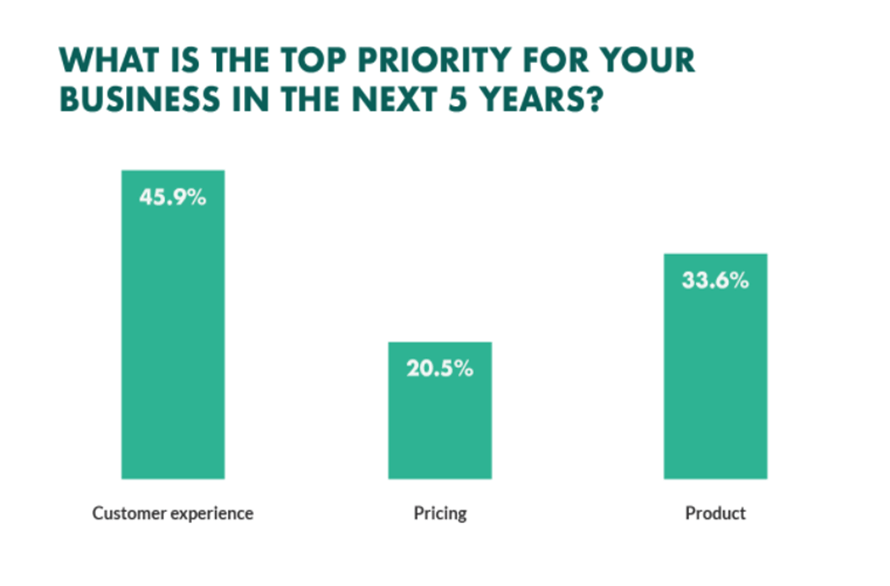- Small businesses expect to lose £11,779 on average. This includes earnings, lost orders, and total revenue. The lost revenue amounts to be £69 billion for about 5.8 million small businesses in the country.
- An estimated 230,000 small and medium enterprises (SMEs) have shut down permanently.
- A third of entrepreneurs (about 35%) have borrowed money from friends and family.
- One in 10 (about 8%) of business owners took private bank loans to stay afloat.
Small Business Trends in Ecommerce and Customer Service in 2021
At the beginning of 2020, business pundits predicted a big year for UK’s small and medium-sized businesses. This projection was despite the political and economic uncertainty.
In fact, one of the biggest predictions was that small businesses would thrive in the new year. Some even thought 2020 would be the best year on record for new businesses in the UK. From AI to sustainability, several business trends were making the rounds.
Fast forward to March 2020, the country entered complete lockdown as uncertainty loomed ahead.
The novel coronavirus pandemic forced as many as 67% of small businesses out of operation.
Simply Business reports that:
Changing Trends in Business: Expected ecommerce trends for 2021
Expansion of eCommerce
There will be about 2.14 billion global digital buyers by 2021 – that’s nearly 27% of the world’s entire population shopping online! Online shopping has become the daily norm for millions of UK customers. Your small business can jump on this wagon and seek ways to cash in on this trend. Even if you don’t sell tangible products, the eCommerce model will still work for you. You can replace your in-store offerings with:- Helpful information,
- Affiliate marketing opportunities, or
- Anything else that’s of relevance to your target audience.
Online and offline buying options
Historically, there was no overlap between shopping in-person and online purchases. Both these activities involved separate interactions and customer experiences. But with everything online, hybrid shopping models will become prominent. Some common examples of this mode of buying and selling are:- Restaurants making deliveries through Deliveroo and UberEATS, or
- Customers placing an order on Asda and picking up the delivery from the curb-side.
Innovation in business models
Businesses should prioritise innovation today to unlock their post-crisis growth. Any crisis presents a choice – an opportunity to grow or stagnate. Every entrepreneur should reflect on what they’re offering and the way their business model operates. McKinsey & Company’s surveyed over 200 organisations across a spectrum of industries. The survey found that nearly 90 % of executives expect the fallout from COVID-19 to fundamentally change their way of doing business. Three-fourth of respondents also feel that the crisis will pave way for opportunities. downward graphsSuccess story:
Stay Golden is a trendy eats and coffee restaurant in Nashville, USA. When the pandemic forced restaurants to shut down, Stay Golden quickly pivoted its business to sell:- Dinner and brunch items as put-it-yourself boxes for customers
- Mixed cocktails to go
Increasing the variety of offerings
One way to continue sales is to penetrate new markets. While eCommerce is one way to go about it, brick-and-mortar stores can also try doing this. For example, a bakery could introduce beverages. Home maintenance companies could upsell customers on combination services. Salon owners could offer daycare to kids who accompany their parents. It’s not difficult to expand the offerings. Innovation and thinking out of the box are two core skills required to excel in this area.Businesses can make an informed decision to:
- Adapt their core functionality to meet the shifting needs of consumers,
- Study and quickly address new opportunity areas,
- Revaluate innovation initiatives and allocate resources accordingly, and
- Construct the foundation for post-pandemic growth to stay competition-relevant in the recovery period.
Success story:
UK-based Chai Guys would have lost everything in the pandemic. They couldn’t receive financial help and their revenue stream dried up. The founders were about to open a fourth outlet in Convent Garden. Instead, they had to close up shop completely. But within 5 days of shutting shop, they started selling spice blends and tea online. They did so well, that just weeks later, they secured a Salesforce small business grant. After this, they got an entry on Deliveroo. Now, Chai Guys have three revenue streams and two new products, not to mention a steady source of income.On the customer service front
A Forbes survey shows that in the post-pandemic world, as many as 59% of consumers will pay even more heed to customer experience than before. So, what does this mean for small businesses? It means that there’s little room for mistakes. Any friction in the shopping journey of your customer will mean lost revenue and the potential gain for your competitors. Try incorporating these business trends to make your venture more customer-friendly.Changing trends in business: Expected customer service trends for 2021
-
Customer service will be a priority for businesses
 Image credits: SuperOffice
Image credits: SuperOffice
READ ALSO: HOW TO HANDLE DIFFICULT CUSTOMERS
-
Multichannel servicing will increase
Success story:
The furniture conglomerate invests heavily in customer experience. No matter which IKEA store you visit around the world, you will get the same experience. Customers laud the company for its efforts; not just by making IKEA one of the most beloved companies in the world, but also taking their annual revenues to over $40 billion worldwide. Not saying that you should compete with IKEA. But there are certainly lessons to be learnt from its raving success.-
Customers EXPECT a seamless mobile experience
Leave a Comment